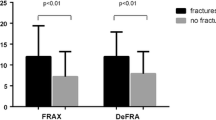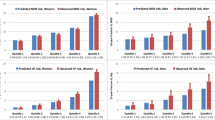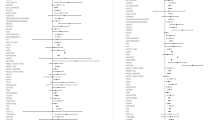Abstract
Summary
In 770 postmenopausal women, the fracture incidence during a 4-year follow-up was analyzed in relation to the fracture probability (FRAX risk assessment tool) and risk (Garvan risk calculator) predicted at baseline. Incident fractures occurred in 62 subjects with a higher prevalence in high-risk subgroups. Prior fracture, rheumatoid arthritis, femoral neck T-score and falls increased independent of fracture incidence.
Introduction
The aim of the study was to analyze the incidence of fractures during a 4-year follow-up in relation to the baseline fracture probability and risk.
Methods
Enrolled in the study were 770 postmenopausal women with a mean age of 65.7 ± 7.3 years. Bone mineral density (BMD) at the proximal femur, clinical data, and fracture probability using the FRAX tool and risk using the Garvan calculator were determined. Each subject was asked yearly by phone call about the incidence of fracture during the follow-up period.
Results
Of the 770 women, 62 had a fracture during follow-up, and 46 had a major fracture. At baseline, BMD was significantly lower, and fracture probability and fracture risk were significantly higher in women who had a fracture. Among women with a major fracture, the percentage with a high baseline fracture probability (>10 %) was significantly higher than among those without a fracture (p < 0.01). Fracture incidence during follow-up was significantly higher among women with a high baseline fracture probability (12.7 % vs. 5.2 %) and a high fracture risk (9.2 vs. 5.3 %) so that the “fracture-free survival” curves were significantly different (p < 0.05). The number of clinical risk factors noted at baseline was significantly associated with fracture incidence (chi-squared = 20.82, p < 0.01). Prior fracture, rheumatoid arthritis, and femoral neck T-score were identified as significant risk factors for major fractures (for any fractures, the influence of falls was also significant).
Conclusions
During follow-up, fracture incidence was predicted by baseline fracture probability (FRAX risk assessment tool) and risk (Garvan risk calculator). A number of clinical risk factors and a prior fracture, rheumatoid arthritis, femoral neck T-score, and falls increased independent of fracture incidence.




Similar content being viewed by others
References
Kanis JA, Johnell O, Oden A et al (2008) FRAX™ and the assessment of fracture probability in men and women from the UK. Osteoporos Int 19:385–397
Nguyen ND, Frost SA, Centre JR et al (2007) Development of a nomogram for individualizing hip fracture risk in men and women. Osteoporos Int 18:1109–1117
Nguyen ND, Frost SA, Centre JR et al (2008) Development of prognostic nomograms for individualizing 5-year and 10-year fracture risks. Osteoporos Int 19:1431–1444
Tremollieres AF, Pouilles JM, Drewniak N, Laparra J, Ribot CA, Dargent-Molina P (2010) Fracture risk prediction using BMD and clinical risk factors in early postmenopausal women: sensitivity of the WHO FRAX tool. J Bone Miner Res 25:1002–1009
Czerwiński E, Kanis JA, Osieleniec J et al (2011) Evaluation of FRAX to characterise fracture risk in Poland. Osteoporos Int 22:2507–2512
Tamaki J, Iki M, Kadowaki E et al (2011) Fracture risk prediction using FRAX®: a 10-year follow-up survey of the Japanese Population-Based Osteoporosis (JPOS) Cohort Study. Osteoporos Int 22:3037–3045
Fraser LA, Langsetmo L, Berger C et al (2011) Fracture prediction and calibration of a Canadian FRAX® tool: a population-based report from CaMos. Osteoporos Int 22:829–837
Bolland MJ, Siu ATY, Mason HB et al (2011) Evaluation of the FRAX and Garvan fracture risk calculators in older women. J Bone Miner Res 25:420–427
Azagra R, Roca G, Encabo G et al (2012) FRAX® tool, the WHO algorithm to predict osteoporotic fractures: the first analysis of its discriminative and predictive ability in the Spanish FRIDEX cohort. BMC Musculoskelet Disord 13:204
Cordomi CT, del Rio LM, Di Gregorio S et al (2013) Validation of the FRAX predictive model for major osteoporotic fracture in a historical cohort of Spanish women. J Clin Densitom 16:231–237
Czerwiński E, Borowy P, Kumorek A, Amarowicz J, Górkiewicz M, Milert A (2013) Fracture risk prediction in outpatients from Krakow region using FRAX tool versus fracture risk in 11-year follow-up. Ortop Traumatol Rehabil 6:617–628
Leslie WD, Brennan SL, Lix LM et al (2013) Direct comparison of eight national FRAX® tools for fracture prediction and treatment qualification in Canadian women. Arch Osteoporos 8:145
Crandall CJ, Larson JC, Watts NB et al (2014) Comparison of fracture risk prediction by the US Preventive Services Task Force strategy and two alternative strategies in women 50-64 years old in the Women's Health Initiative. J Clin Endocrinol Metab 99:4514–4522
Rubin KH, Abrahamsen B, Friis-Holmberg T et al (2013) Comparison of different screening tools (FRAX®, OST, ORAI, OSIRIS, SCORE and age alone) to identify women with increased risk of fracture. A population-based prospective study. Bone 56:16–22
Pluskiewicz W, Adamczyk P, Czekajło A, Grzeszczak W, Burak W, Drozdzowska B (2012) Epidemiological data on osteoporosis in women from the RAC-OST-POL study. J Clin Densitom 15:308–314
Włodarek D, Głąbska D, Kołota A et al (2014) Calcium intake and osteoporosis: the influence of calcium intake from dairy products on hip bone mineral density and fracture incidence – a population-based study in women over 55 years of age. Public Health Nutr 17:383–389
Drozdzowska B, Wiktor K, Pluskiewicz W (2013) Functional status and prevalence of falls and fractures in population-based sample of postmenopausal women from the RAC-OST-POL Study. Int J Clin Pract 67:673–681
Pluskiewicz W, Adamczyk P, Czekajło A, Grzeszczak W, Burak W, Drozdzowska B (2014) Influence of education, marital status, occupation, and the place of living on skeletal status, fracture prevalence, and the course and effectiveness of osteoporotic therapy in women in the RAC-OST-POL Study. J Bone Miner Metab 32:89–95
Rokicki W, Drozdzowska B, Czekajło A, et al (2015) Relationship between visual status and functional status and the risk of falls in postmenopausal women, the RAC-OST-POL Study. Arch Med Sci (in press)
Lorenc R, Głuszko P, Karczmarewicz E. et al (2013) Recommendations for diagnostic and therapeutic management in osteoporosis (in Polish). Medycyna Praktyczna 1–48
Jarvinen TLN, Sievanen H, Khan KM, Heinonen A, Kannus P (2008) Shifting the focus in fracture prevention from osteoporosis to falls. BMJ 336:124–126
Pluskiewicz W, Drozdzowska D, Adamczyk P (2013) Ten-year risk in the assessment of osteoporosis management efficacy in postmenopausal women: a pilot study. Climacteric 16:117–126
Pluskiewicz W, Adamczyk P, Franek E et al (2010) Ten-year probability of osteoporotic fracture in 2012 Polish women assessed by FRAX and nomogram by Nguyen et al. – conformity between methods and their clinical utility. Bone 46:1661–1667
Conflicts of interest
None.
Author information
Authors and Affiliations
Corresponding author
Rights and permissions
About this article
Cite this article
Pluskiewicz, W., Adamczyk, P., Czekajło, A. et al. High fracture probability predicts fractures in a 4-year follow-up in women from the RAC-OST-POL study. Osteoporos Int 26, 2811–2820 (2015). https://doi.org/10.1007/s00198-015-3196-9
Received:
Accepted:
Published:
Issue Date:
DOI: https://doi.org/10.1007/s00198-015-3196-9




